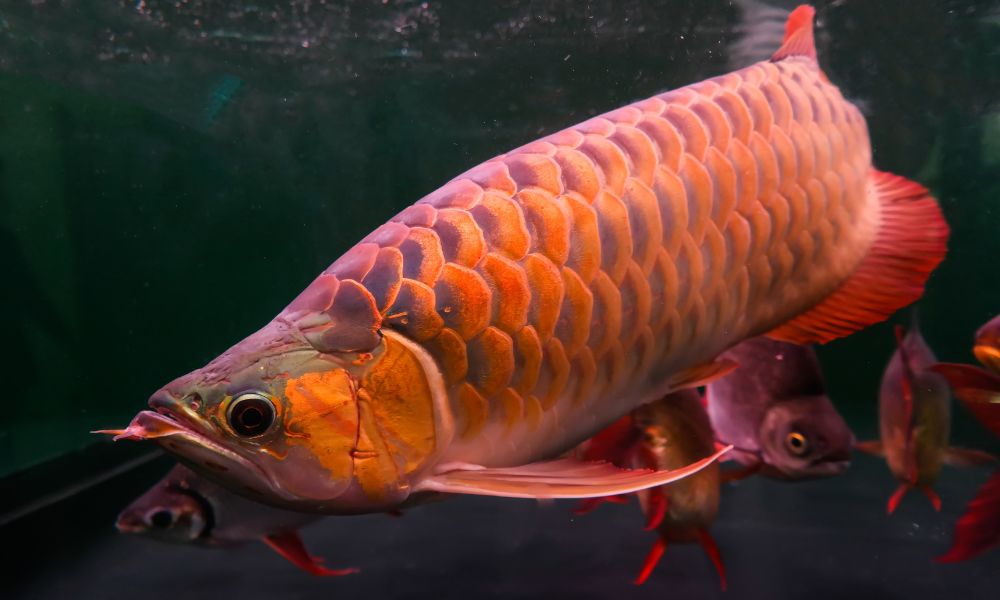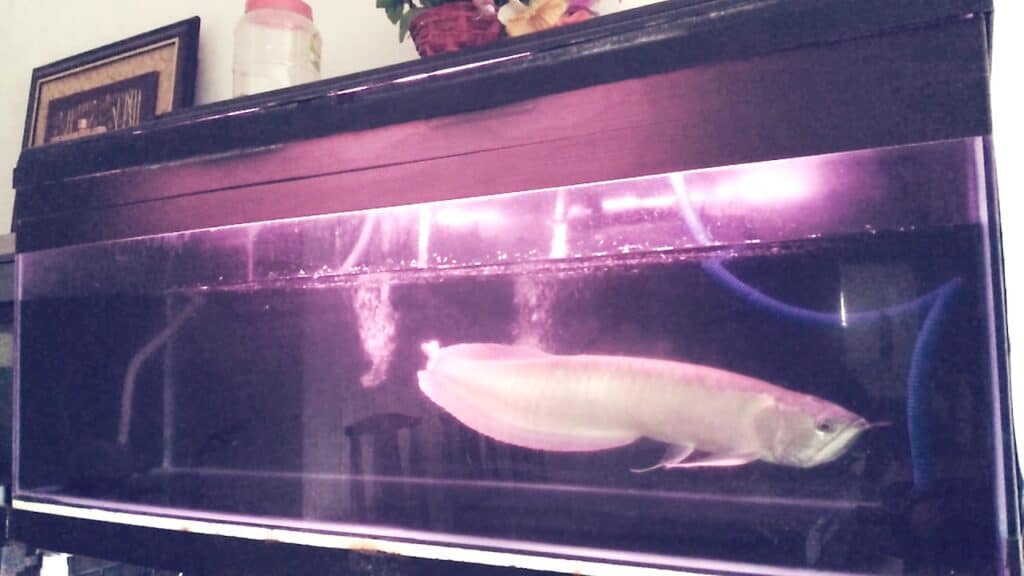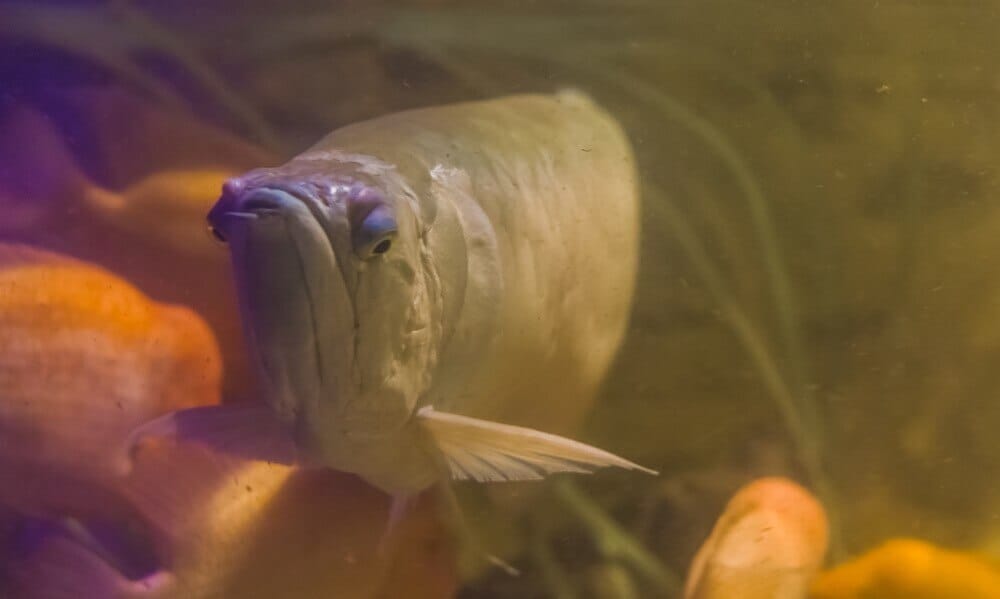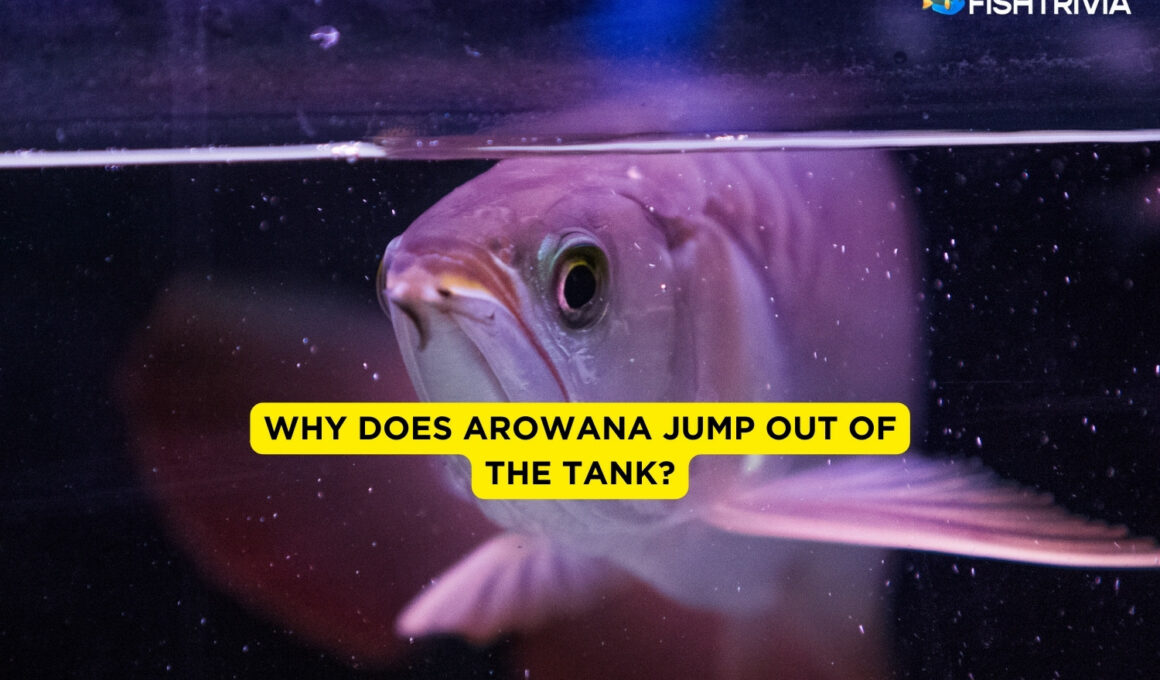In this article Show
If you’re an aquarium enthusiast, you’ve probably marveled at the beauty and grace of Arowana fish. These magnificent creatures, often the centerpiece of home aquariums, have a curious habit that puzzles and sometimes worries their owners: they jump out of their tanks. But why do Arowanas exhibit this surprising behavior?
In this article, we’ll explore the reasons behind this peculiar activity. As an experienced fish keeper, I understand the nuances of maintaining a balanced aquarium environment and the unique needs of different fish species, including Arowanas.
So, let’s get started with understanding the reasons why Arowanas jump out of their tanks. Whether you’re new to the world of fishkeeping or a seasoned pro, this exploration will enhance your understanding and help you provide the best care for these fascinating fish.
Also worth reading;
- 19 Best Arowana Tank Mates
- Are Arowana Fish Aggressive? All You Need to Know
- What Do Arowana Fish Eat? [Best Food in the Aquarium for Arowana]

Why Do Arowana Jump Out Of Tanks?
Understanding why Arowanas leap from their tanks is crucial for any aquarium hobbyist. These fascinating behaviors, while natural, can be alarming and potentially harmful to the fish. Let’s explore in-depth the various factors contributing to this behavior:
1. Inadequate Tank Conditions
Size and Dimensions of the Tank
Arowanas grow to considerable sizes, often reaching up to 3 feet in length. This rapid growth necessitates a spacious aquarium, typically at least 250 gallons for a single adult Arowana. The lack of adequate swimming space can lead to stress and a feeling of confinement, prompting them to jump.
Water Quality and Temperature
Arowanas thrive in clean, well-oxygenated water with stable conditions. Fluctuations in pH levels, temperature, or ammonia and nitrate concentrations can cause significant stress. They prefer temperatures between 75°F and 86°F. Regular monitoring and maintenance of water conditions are essential to prevent jumping caused by environmental stressors.

2. Stress and Agitation
Presence of Aggressive Tank Mates
While Arowanas themselves can be territorial, housing them with other aggressive or fin-nipping fish can escalate stress levels. This heightened stress can manifest as escape attempts, including jumping out of the tank. It’s important to choose tank mates carefully, ensuring they are compatible in terms of temperament and size.
Frequent Disturbances and Loud Noises
Arowanas are sensitive to their surroundings. Sudden movements, shadows, or loud noises near their tank can startle them. Such disturbances can mimic the presence of predators or other dangers in their natural habitat, triggering a flight response.
3. Natural Instincts and Hunting Behavior
Instinctual Behaviors Related to Their Natural Habitat
In the wild, Arowanas are surface dwellers and skilled jumpers, known to leap out of the water to catch insects and small birds. This natural predatory behavior can still be present in captivity, where they might jump towards food or in response to something they perceive as prey.
Reaction to Perceived Prey or Threats
Reflections from the glass, moving shadows, or even the caretaker’s movements can be misinterpreted as prey or threats. This misinterpretation triggers their instinct to jump, a behavior deeply ingrained from their life in the wild.
4. Health Issues
Signs of Illness or Discomfort Leading to Jumping
Health concerns like skin irritations, parasites, or infections can cause discomfort in Arowanas, leading them to jump as a response to the irritation. Regular health checks and prompt treatment of any visible signs of illness are essential.
5. Other Contributing Factors
Inadequate Lid or Cover
Arowanas’ ability to jump high makes it imperative to have a secure and sturdy lid on their tank. An inadequate or poorly fitting lid invites escape attempts.
Boredom or Lack of Stimulation
Like many intelligent species, Arowanas can become bored in an unstimulating environment. This boredom can manifest in various ways, including jumping. Providing an environment with adequate decoration, plants, and varied food can help keep them engaged.
The tendency of Arowanas to jump out of their tanks is influenced by a combination of tank conditions, stress factors, instinctual behaviors, and health issues. By understanding and addressing these factors, you can create a safer and more comfortable environment for your Arowana, ensuring its health and happiness in your care.

Preventing Your Arowana from Jumping Out
Arowana fish are known for their tendency to jump out of water, a behavior that can be both dangerous for the fish and distressing for the owner. Preventing this requires a combination of proper tank setup, maintenance, and stress reduction strategies. Let’s delve into each of these aspects:
1. Appropriate Tank Setup and Size
- Choosing the Right Tank Size: Start with a tank that is suitable for an adult Arowana, which can grow up to 3 feet in length. A minimum tank size of 250 gallons is recommended. Ensure the tank is more elongated than tall to provide ample swimming space.
- Secure Tank Lid: A sturdy, well-fitted lid is essential. Arowanas are powerful jumpers, and a weak or ill-fitting lid won’t be sufficient to keep them contained. Make sure there are no gaps and the lid can withstand the force of a jump.
- Tank Placement: Position the tank in a low-traffic area to minimize disturbances. Avoid places with loud noises or excessive movement, which could startle the fish.
2. Regular Maintenance and Water Quality Checks
- Consistent Water Quality Monitoring: Regular testing of pH levels, temperature, ammonia, nitrite, and nitrate levels is crucial. Arowanas thrive in clean, stable environments. Sudden changes in water parameters can stress the fish and provoke jumping.
- Routine Water Changes: Regular water changes, typically 10-25% weekly, help maintain a healthy environment. This reduces the build-up of harmful chemicals and ensures optimal water conditions.
- Efficient Filtration System: A good filtration system is necessary to keep the water clean and oxygen-rich. It also helps in maintaining a stable environment, which is crucial for the well-being of Arowanas.
3. Tips on Reducing Stress and Creating a Safe Environment
- Compatible Tank Mates: Choose tank mates wisely. Ideal companions should be peaceful and of similar size to avoid territorial disputes. Crowding the tank with too many fish can increase stress levels.
- Enriched Environment: Provide a stimulating environment with appropriate plants, hiding spots, and decorations. This not only makes the tank more aesthetically pleasing but also gives your Arowana places to explore and retreat, reducing boredom and stress.
- Controlled Feeding: Maintain a regular feeding schedule with a varied diet. Overfeeding can deteriorate water quality, while underfeeding can make Arowanas more aggressive and prone to jumping.
- Minimize Disturbances: Reduce external stressors like loud sounds or vibrations near the tank. Gentle, consistent lighting also helps in keeping your Arowana calm.
By focusing on these key areas, you can significantly decrease the chances of your Arowana jumping out of its tank. A happy and healthy Arowana is less likely to display this risky behavior, ensuring a harmonious coexistence in your home aquarium.










